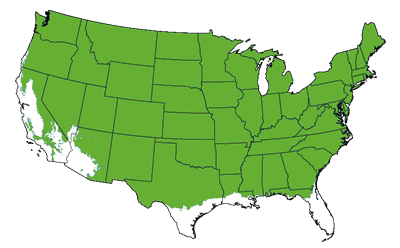Fall Gold Raspberry Plant
Plant Health Guaranteed
Your Plants are Guaranteed
Your Plants are Guaranteed
Your plants are guaranteed to arrive happy & healthy with our 30 Day Plant Promise. Your order will arrive healthy and stay healthy while they adapt to your climate. If not, just call us at (704) 443-8256.
Free Shipping on All Orders
Free Shipping on All Orders
Free shipping on all orders. Your plants will ship out the next business day... expertly packed so that your plants will arrive happy and healthy!
Planting & Care
Planting & Care
|
The Fall Gold Raspberry Plant thrives in Zones 3-8 
If you live in the green area above, we recommend the Fall Gold Raspberry Plant. |
||
| Your Growing Zone | ||
| Recommended Zones | 3-8 | |
| Mature Height | 3-4 ft. | |
| Mature Width | 2-3 ft. | |
| Cannot Ship To | AZ, OR | |
| Sunlight | Full Sun | |
| Botanical Name | Rubus idaeus 'Fall Gold' | |
|
The Fall Gold Raspberry Plant thrives in Zones 3-8 
If you live in the green area above, we recommend the Fall Gold Raspberry Plant. |
|
| Your Growing Zone | |
| Recommended Zones | 3-8 |
| Mature Height | 3-4 ft. |
| Mature Width | 2-3 ft. |
| Cannot Ship To | AZ, OR |
| Sunlight | Full Sun |
| Botanical Name | Rubus idaeus 'Fall Gold' |
Description
Description
Fall Gold Raspberry
Sweet, Golden Raspberries with Exceptional Flavor – Perfect for Home Gardens, Patios, and Berry-Lovers
The Fall Gold Raspberry (Rubus idaeus 'Fall Gold') is a unique and delightful raspberry variety that produces sweet, juicy, golden-yellow berries in both summer and fall. Known for its excellent flavor, this everbearing raspberry delivers two harvests each year—one in early summer and a more abundant crop in late summer to fall. Its golden berries are not only visually striking but also incredibly delicious, making them perfect for fresh eating, jams, desserts, and more. The Fall Gold Raspberry is a hardy and vigorous plant, ideal for home gardeners who want a reliable, productive, and low-maintenance fruit crop.
Sweet, Golden Raspberries Twice a Year
The Fall Gold Raspberry offers the best of both worlds with its everbearing nature. This means you’ll enjoy two harvests each year: a light crop in early summer and a heavier yield in late summer and fall. The berries are large, firm, and sweet with a delicate golden color that stands out in any garden or berry patch. With its exceptional flavor, the Fall Gold Raspberry is a must-have for berry enthusiasts who want something different from the typical red varieties.
Why Choose the Fall Gold Raspberry?
- Unique Golden Berries: This variety produces beautiful golden-yellow raspberries that are visually stunning and have a sweet, honey-like flavor.
- Everbearing for Two Harvests: Enjoy two bountiful harvests each year—one in early summer and another, more abundant crop in late summer through fall.
- Sweet and Juicy Flavor: The Fall Gold raspberry is known for its exceptional flavor, perfect for fresh eating, baking, or making homemade jams and preserves.
- Hardy and Productive: This raspberry plant is hardy, vigorous, and produces a reliable crop year after year, even in colder climates (USDA Zones 3-8).
- Easy to Grow: With minimal care, the Fall Gold Raspberry will thrive in home gardens or containers, making it an excellent choice for beginner and experienced gardeners alike.
Ideal Placement and Uses
- Home Gardens & Berry Patches: Plant Fall Gold Raspberries in your backyard garden or berry patch to enjoy fresh, homegrown fruit. Their compact size makes them easy to incorporate into any garden layout.
- Containers & Patios: Grow these raspberries in large containers on your patio, balcony, or deck, where they can thrive and provide easy access to delicious berries for snacking.
- Edible Landscaping: The beautiful golden berries add an ornamental touch to edible landscapes, allowing you to enjoy both beauty and function in your garden.
- Fresh Eating & Preserving: Fall Gold raspberries are perfect for eating fresh off the bush, making smoothies, or creating homemade jams, jellies, and desserts.
Growing Tips
- Light: The Fall Gold Raspberry thrives in full sun, requiring at least 6-8 hours of direct sunlight per day for the best fruit production and flavor.
- Watering: Water regularly, especially during dry periods, to keep the soil consistently moist but not waterlogged. Raspberries prefer well-drained soil with even moisture.
- Soil: Plant in rich, well-drained soil that is slightly acidic to neutral. Adding organic compost will improve soil fertility and drainage.
- Fertilization: Feed with a balanced, slow-release fertilizer in early spring and mid-summer to support healthy growth and abundant fruiting.
- Pruning: Prune canes in late winter or early spring, removing old canes that have already fruited to encourage new growth. For the best fall crop, trim back summer-bearing canes after the first harvest.
Why Buy from Nationwide Plants?
When you purchase a Fall Gold Raspberry from Nationwide Plants, you’re choosing a top-quality plant grown with expert care. We guarantee:
- Healthy, well-established plants delivered to your door.
- Fast, secure shipping to ensure your raspberry plant arrives in perfect condition.
- Expert growing advice to help you enjoy an abundant harvest for years to come.
Whether you’re a berry enthusiast looking to grow something unique or simply want to enjoy the sweet, sun-ripened taste of golden raspberries, the Fall Gold Raspberry is the perfect choice. With its two annual harvests and beautiful, honey-sweet fruit, this raspberry will become a treasured addition to your garden or patio.
Order your Fall Gold Raspberry today and enjoy delicious, homegrown berries all season long!







